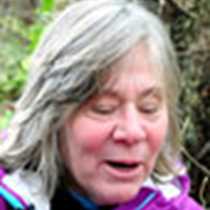Lake Eva Trail & Hood Bay
Mists drew gauzy curtains of fine water droplets across the landing at Hanus Bay, where we stepped onto the Lake Eva trail and entered the lichen and moss festooned trees of the Southeast Alaska rainforest. It is the last hike of the week and the Tongass National Forest ecosystem is now very familiar to us – we see the lungwort lichens lying on the mossy forest floor and know that they will eventually add their nitrogen to the nutrient-poor system. The large Sitka spruce blown down by the winter winds exposes its shallow root system and opens a window into the canopy that allows the western hemlock seedlings waiting in the understory to shoot up into the light. Much of the forest is in a natural state of decomposition and covered with mosses and fungi, whose invisible threads break down the dead plant material and provide sustenance for the next generation.
Signs of forest dwellers are everywhere. New shoots of chocolate lily leaves carpet an open area along the forest edge. They are disturbed; some have been dug up by a hungry brown bear newly emerged from its den. The lily root is made up of bulblets which look like a small ball of rice and are a tasty and surely very welcome carbohydrate after a long fast. Many of the smaller blueberry bushes in the understory have been browsed by Sitka-black tailed deer foraging through the long winter.
A low tide in the late afternoon beckons us into Hood Bay on Admiralty Island for some rainy afternoon cruising. Admiralty Island is known as ‘Kootznahoo’ or the ’fortress of the bears’ to the Tlingit people. It is an apt name. At nearly one bear per square mile, the island is home to the greatest per capita number of brown bears anywhere in the world! We are not disappointed. In one of the lower meadows, judging by its size a large adult male checks us out as we cruise past. He stands on his haunches several times to gauge the situation, and apparently deems us harmless. Across the bay, another much smaller and thinner juvenile bear walks slowly down the beach, looking hungry and forlorn. Perhaps her mother has recently pushed her from the den and she is on her own.
The rainforest landscape surrounds our wonderful little vessel and this evening we gather to celebrate a fabulous week together with songs of bears and stories from Raven and Robert Sevice.
Mists drew gauzy curtains of fine water droplets across the landing at Hanus Bay, where we stepped onto the Lake Eva trail and entered the lichen and moss festooned trees of the Southeast Alaska rainforest. It is the last hike of the week and the Tongass National Forest ecosystem is now very familiar to us – we see the lungwort lichens lying on the mossy forest floor and know that they will eventually add their nitrogen to the nutrient-poor system. The large Sitka spruce blown down by the winter winds exposes its shallow root system and opens a window into the canopy that allows the western hemlock seedlings waiting in the understory to shoot up into the light. Much of the forest is in a natural state of decomposition and covered with mosses and fungi, whose invisible threads break down the dead plant material and provide sustenance for the next generation.
Signs of forest dwellers are everywhere. New shoots of chocolate lily leaves carpet an open area along the forest edge. They are disturbed; some have been dug up by a hungry brown bear newly emerged from its den. The lily root is made up of bulblets which look like a small ball of rice and are a tasty and surely very welcome carbohydrate after a long fast. Many of the smaller blueberry bushes in the understory have been browsed by Sitka-black tailed deer foraging through the long winter.
A low tide in the late afternoon beckons us into Hood Bay on Admiralty Island for some rainy afternoon cruising. Admiralty Island is known as ‘Kootznahoo’ or the ’fortress of the bears’ to the Tlingit people. It is an apt name. At nearly one bear per square mile, the island is home to the greatest per capita number of brown bears anywhere in the world! We are not disappointed. In one of the lower meadows, judging by its size a large adult male checks us out as we cruise past. He stands on his haunches several times to gauge the situation, and apparently deems us harmless. Across the bay, another much smaller and thinner juvenile bear walks slowly down the beach, looking hungry and forlorn. Perhaps her mother has recently pushed her from the den and she is on her own.
The rainforest landscape surrounds our wonderful little vessel and this evening we gather to celebrate a fabulous week together with songs of bears and stories from Raven and Robert Sevice.




